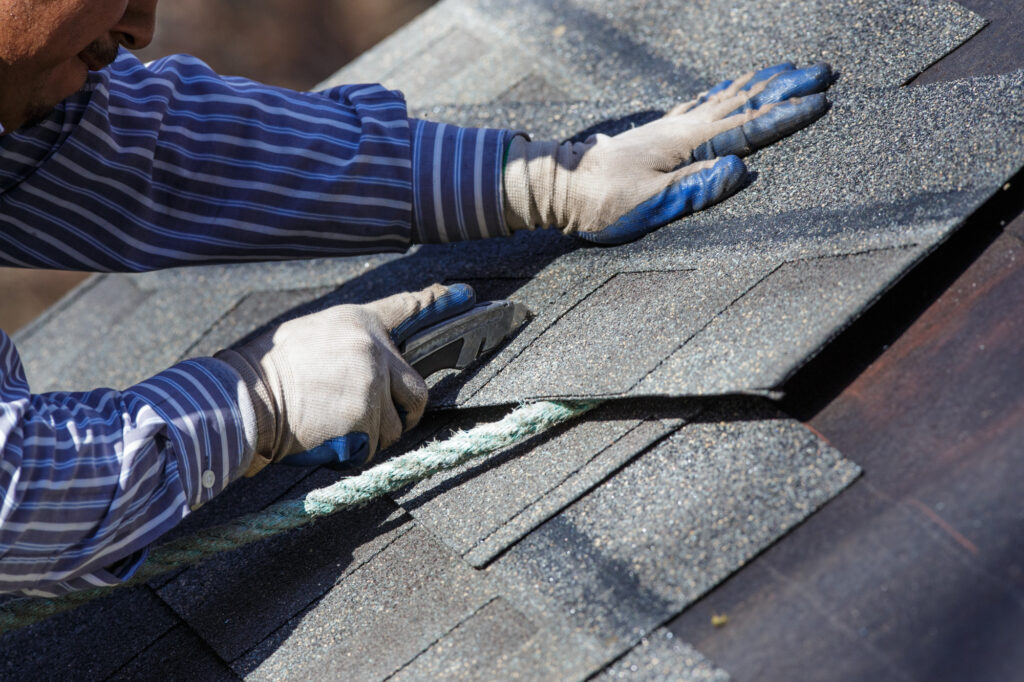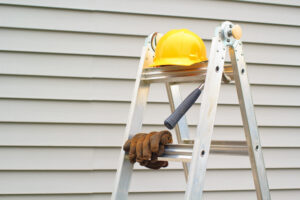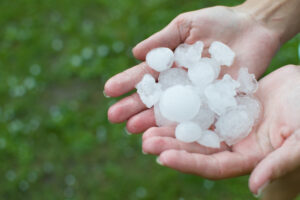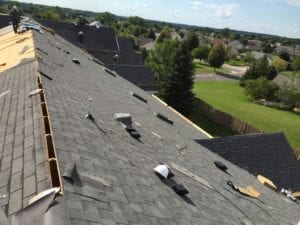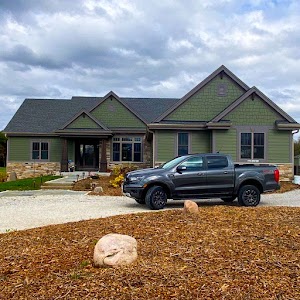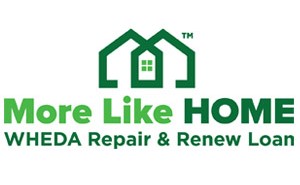Roof algae, mainly identified as the blue-green algae Gleocapsa magma, appears as unsightly dark streaks on roofing materials, thriving in humid and shaded conditions. It typically grows due to the moisture accumulation and nutrients found in roofing shingles, particularly limestone. To fix the problem, a 50/50 bleach and water solution can effectively clean the affected areas. It’s crucial to protect surrounding vegetation during the process. For prevention, maintaining proper ventilation, trimming overhanging branches, and installing copper or zinc strips can inhibit future growth. Understanding these aspects can help guarantee the longevity of your roof and improve curb appeal.
Understanding Roof Algae
Roof algae, primarily composed of the blue-green algae Gleocapsa magma, manifests as unsightly streaks on roofing materials.
This organism thrives in humid, shaded conditions where moisture accumulates, facilitating its spread through wind and animal activity.
Understanding its characteristics and transmission is essential for effective management and prevention strategies.
What Is Roof Algae?
Algae, specifically the blue-green species Gloeocapsa magma, often manifests as unsightly dark streaks on roofing materials, considerably affecting the aesthetic appeal of buildings.
Roof algae thrive in humid environments where moisture and shade are prevalent, making certain roofs particularly susceptible to its growth. These black streaks not only detract from a property’s visual charm but can also lead to more severe implications if left untreated.
The algae’s proliferation is accelerated by the presence of nutrients found in some roofing shingles, especially limestone. Furthermore, roof algae can spread easily through wind and animal activity, creating new colonies on nearby surfaces.
While the primary concern with roof algae is its impact on appearance, persistent growth can result in permanent staining and potentially contribute to underlying material degradation over time.
Moreover, roof algae can create favorable conditions for other organisms like moss and lichen, which retain moisture and may lead to wood rot.
Regular maintenance, including inspections and the removal of debris, is essential for preventing roof algae establishment, thereby preserving both the aesthetic and structural integrity of roofing systems.
How Does Roof Algae Spread?
How does the spread of roof algae occur in residential areas? Roof algae, primarily the blue-green algae Gleocapsa magma, can quickly proliferate, particularly in humid and coastal climates.
The spread occurs through airborne spores that are transported by wind, animals, and water, making it easy for neighboring roofs to become infected. Once established, the algae thrive in shaded, moist environments, where excessive shade from trees and moisture retention on roof surfaces create ideal conditions for growth.
The presence of roof algae often results in unsightly streaks that diminish a property’s curb appeal and may lead to decreased property value. While this algae does not typically damage roofing materials, timely removal is essential. If neglected, roof algae can continue to spread, affecting more shingles and potentially neighboring roofs, exacerbating the issue.
Effective prevention strategies include reducing shade by trimming overhanging branches, regularly clearing roof debris, and installing metal strips that inhibit algae growth.
Signs and Causes of Roof Algae
Recognizing roof algae is essential for maintaining the aesthetic and structural integrity of your home.
Typically appearing as dark streaks or discoloration, these signs indicate an environment conducive to algae growth, often exacerbated by moisture and shade.
Understanding the underlying causes, such as nutrient-rich roofing materials and poor ventilation, can help in implementing effective prevention strategies.
How to Recognize Roof Algae
The presence of roof algae can often be identified by the emergence of unsightly black streaks, green or white spots, and round lichens on shingles. This algae, primarily composed of the blue-green species Gleocapsa magma, thrives in humid conditions and is particularly prevalent on north-facing roofs that receive less sunlight.
The growth of algae is facilitated by moisture retention on roof surfaces, excessive shade from overhanging trees, and the accumulation of organic debris such as leaves and twigs.
Homeowners may also notice other indicators of algae presence, including peeling paint or mold on chimneys, which signal potential moisture problems that should be addressed. The unsightly nature of these streaks not only diminishes the roof’s visual appeal but can also affect the overall property value and curb appeal.
Early recognition of roof algae is essential for homeowners to maintain the integrity of their roofs. By identifying the signs of algae growth promptly, appropriate preventive measures can be taken to mitigate further proliferation and protect the roofing materials from potential long-term effects.
What Causes Roof Algae Growth?
Algae growth on roofs is primarily driven by environmental conditions that favor its proliferation. Roof algae, particularly Gloeocapsa magma, thrives in humid environments where moisture is abundant.
Shaded areas, especially those under trees, limit sunlight exposure and create ideal conditions for algae to flourish. This growth is often observed as dark streaks on shingles, particularly on roofs with northern exposure where UV light is less intense.
The presence of nutrients in roofing materials, especially limestone, further exacerbates the issue, providing essential sustenance for algae. Airborne spores can easily spread roof algae, carried by wind or animals, allowing it to infiltrate neighboring structures.
Signs of its growth include unsightly discoloration and moss accumulation, both of which may indicate moisture retention that could lead to structural damage if ignored.
Additionally, poor attic ventilation and the accumulation of organic debris on the roof’s surface contribute to moisture retention, enhancing the likelihood of algae growth.
To mitigate these factors, homeowners should consider trimming overhanging branches, maintaining clear drainage, and improving airflow in the attic space to safeguard against roof algae proliferation.
How to Remove Roof Algae
Removing roof algae effectively requires a combination of DIY methods and the right tools, alongside adhering to safety precautions.
A balanced approach, using a bleach and water solution, can help restore your roof’s appearance while protecting surrounding vegetation.
Understanding these techniques will empower homeowners to address algae issues efficiently.
DIY Methods for Roof Algae Removal
While roof algae can be an unsightly nuisance, effectively addressing the issue with DIY methods is entirely feasible. One of the most effective techniques involves creating a 50/50 solution of household bleach and water. This mixture should be applied using a hose-end sprayer to minimize damage to the shingles.
It is essential to allow the solution to dwell on the affected areas for approximately 15-20 minutes before rinsing with low-pressure water, ensuring that no residue remains.
Before beginning the cleaning process, protect surrounding plants and lawn by covering them with clear plastic sheeting to prevent bleach overspray. Regular maintenance is key to preventing future algae growth; using a leaf blower to clear debris and trimming overhanging branches can greatly reduce the conditions that favor algae proliferation.
For those seeking long-term solutions, consider installing copper or zinc strips underneath the roof peak. These metals can inhibit the growth of roof algae during rainfall, providing a proactive approach to maintaining the aesthetics and longevity of your roof.
Essential Tools & Safety Precautions
Effective roof algae removal requires the right tools and adherence to safety precautions to guarantee a successful and safe cleaning process. The essential tools for this task include a garden sprayer or a low-pressure pressure washer for applying the cleaning solution, a ladder to safely access the roof, and a long-handled brush to scrub the affected areas without damaging the shingles.
In addition to the tools, appropriate safety equipment is vital. Protective eyewear and gloves should be worn to prevent injury from bleach and debris. A safety harness is recommended for stability while working at heights, and non-slip shoes will provide secure footing on the roof.
When preparing the cleaning solution, a 50/50 mixture of bleach and water is effective, but care must be taken to shield surrounding plants and surfaces from overspray.
It is advisable to use a hose-end sprayer instead of high-pressure washing to maintain the shingles’ integrity.
Finally, perform the cleaning on calm, overcast days to minimize risks and enhance effectiveness, ensuring all safety measures are in place before commencing work.
Professional Roof Cleaning: When to Call an Expert
When DIY methods fail to effectively eliminate roof algae, it may be time to contemplate a professional cleaning service.
Licensed contractors possess the expertise and equipment necessary to tackle extensive growth safely and efficiently.
Their assessment can also identify any underlying damage, allowing for informed decisions regarding repairs or maintenance.
When DIY Isn’t Enough
As homeowners endeavor to maintain the aesthetics and integrity of their roofs, there comes a point when DIY cleaning methods may prove insufficient against persistent algae growth. When widespread algae infestations endure despite homeowners’ best efforts, it often indicates deeper penetration into roofing materials that requires a professional assessment.
Attempting to clean steep or high roofs can pose considerable safety risks, making it prudent to engage experts who possess the necessary safety gear and specialized tools.
Professionals are equipped to effectively evaluate the severity of algae infestations, determining whether a thorough cleaning is sufficient or if shingle replacement is necessary to prevent further damage.
Moreover, prolonged exposure to algae can lead to mold and mildew development, which presents potential health risks. In such cases, professional intervention is essential for safe and thorough removal.
By opting for timely professional cleaning, homeowners can enhance the longevity of their roofing materials, greatly reducing the likelihood of costly repairs or replacements due to neglect and extensive algae damage.
Choosing a Professional Roof Cleaning Service
How can homeowners determine the right moment to engage a professional roof cleaning service? The presence of extensive algae growth on a roof is a primary indicator that professional roof cleaning may be necessary.
While DIY methods can be effective for minor issues, persistent or resistant algae growth signals the need for expert intervention. Professionals possess the tools, expertise, and cleaning solutions to safely remove algae without damaging roofing materials, unlike many home remedies.
Additionally, homeowners with steep or complex roof designs should consider safety risks when attempting to clean their roofs. Hiring professionals not only guarantees safety but also provides a thorough assessment of the roof’s condition, identifying any underlying issues that might contribute to algae growth.
Furthermore, choosing a reputable roof cleaning service offers the added benefit of warranties or guarantees on their work, giving homeowners peace of mind regarding ongoing maintenance.
Ultimately, recognizing the signs of significant algae presence and understanding the limitations of DIY efforts can guide homeowners in making informed decisions about when to call in the experts for professional roof cleaning.
Preventing Roof Algae Growth
To effectively prevent roof algae growth, it is essential to reduce shade and moisture on the roof surface.
Trimming overhanging branches can enhance sunlight exposure, while the installation of algae-resistant materials, such as zinc or copper strips, provides ongoing protection.
These proactive measures create an unfavorable environment for algae, promoting a cleaner and more visually appealing roof.
Reducing Shade and Moisture
Shade and moisture are primary contributors to the growth of roof algae, necessitating effective management strategies to prevent its proliferation. One of the most impactful measures is trimming overhanging branches. By reducing shade on the roof, you can enhance sunlight exposure, which aids in drying moisture and deterring algae development.
Additionally, regular roof maintenance is essential. Clearing debris such as leaves and twigs prevents the accumulation of organic matter, which retains moisture and creates a conducive environment for algae.
Proper roof ventilation is also vital; it promotes airflow that minimizes moisture accumulation, further reducing the risk of algae growth.
Moreover, redirecting drainage spouts away from the roof can help avoid water pooling, which contributes to moisture retention on the roof surface.
By implementing these strategies, homeowners can effectively mitigate the factors that lead to roof algae proliferation, maintaining both the aesthetic and functional integrity of their roofs.
Taking proactive steps in managing shade and moisture guarantees a healthier roof environment, ultimately extending its lifespan and preserving its appearance.
Installing Algae-Resistant Materials
While traditional roofing materials may require frequent maintenance to combat algae growth, installing algae-resistant materials offers a more sustainable solution for homeowners.
These innovative roofing options, often infused with copper or zinc granules, effectively inhibit the growth of algae, considerably reducing the need for regular cleaning and repairs.
When homeowners consider roof replacement, choosing algae-resistant shingles is a wise investment.
These materials are designed to release biocides upon exposure to moisture, preventing algae spores from establishing themselves on the roof.
By mitigating algae growth, these shingles not only preserve the roof’s aesthetic appeal but also enhance the overall value of the property.
A cleaner, more uniform roof appearance can greatly improve curb appeal, which is particularly beneficial when the home goes on the market.
Additionally, the longevity of algae-resistant materials means that homeowners can enjoy years of reduced maintenance costs alongside the visual benefits.
As algae growth diminishes, the likelihood of unsightly streaks and discoloration is minimized, ensuring that the roof remains an attractive feature of the home.
Final Thoughts on Roof Algae Removal
Addressing roof algae promptly is crucial for maintaining both the aesthetic appeal and structural integrity of your home. The presence of Gloeocapsa magma can lead to unsightly streaks, which, while not directly damaging, can harbor moisture and potentially contribute to mold growth.
Effective roof cleaning involves applying a 50/50 bleach and water solution, allowing it to dwell for 15-20 minutes, followed by a gentle rinse to protect your shingles.
To prevent future algae growth, regular maintenance is important. This includes clearing debris that can trap moisture and trimming overhanging branches to reduce shade—ideal conditions for algae proliferation.
Additionally, installing copper or zinc strips can serve as a long-term solution, releasing ions during rainfall that inhibit algae development.
Taking prompt action when algae is first noticed can prevent more significant issues down the line. It is advisable to monitor your roof regularly and address any signs of algae early.

